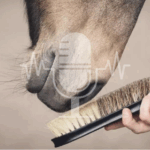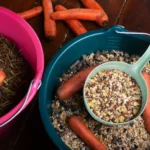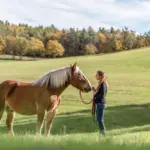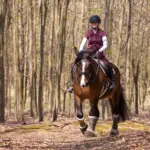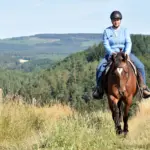What should you consider when searching for a new place to stay for your companion?
Getting your own horse often happens faster than expected. But finding the right boarding or livery yard for your beloved friend is like hitting the jackpot. When you flip through local classified ads, you might initially think it can’t be that difficult – after all, you drive past dozens of barns on your way to work every day. However, once you get into the details, the number of yards that truly offer species-appropriate housing and care quickly dwindles to very few.
The first question that arises is:
Open stable concept with horses living outside 24/7 in a group or stabling with single stalls? Both housing systems have advantages, and both have disadvantages.
If you have a young horse that’s spirited and has a strong need for movement, you should definitely consider open stable housing. However, if you have a senior horse that might need large amounts of soaked haypellets fed daily due to dental issues, or one that’s lower in the pecking order and anxious, then most group-stabling-systems are already ruled out because such a horse will not get adequate rest there.
In this case, you should look for a stable where horses are turned out in small groups to spacious paddocks during the day but return to their stalls in the evening. Continuous confined housing in single stalls is just as contrary to animal welfare as keeping horses in an open stable that causes chronic stress due to overcrowding, antisocial group members, or poor management.
Beyond the appropriate housing concept, many other factors come into play, such as accessibility, forage management, supplemental feeding, riding arena, indoor arena, trail riding terrain, additional services like presenting horses to the farrier, and so on.
Some of these points are more important for the owner. After all, the horse doesn’t care whether there’s a cozy, heated riders’ lounge, but the human certainly might.
Other points concern the horse exclusively, for example, group composition or paddock size. Some points are negotiable – it might not have to be the barn with an indoor arena; a lit outdoor arena might suffice. Others are absolute deal-breakers, such as feeding moldy hay.
A barn change is an important decision and involves considerable stress for the horse – as well as for the group into which the horse will be integrated. Rather than hastily agreeing to something only to move out again after six weeks, it’s more sensible to critically examine several points during the barn search to determine whether the barn truly fits. It’s better to search a bit longer or get on a waiting list at a good barn than to become a “barn hopper” because the first one was too expensive, the second too far away, and the third simply not suitable for the horse at all.
Initial considerations before opening the classified ads:
What’s my budget?
Don’t calculate too tightly here, because monthly costs are joined by travel expenses, hoof care, veterinary bills, etc. To avoid quickly finding yourself financially backed against a wall, you should plan the barn rent realistically and check whether this is truly sustainable long-term with your monthly available income. Many barns offer complex pricing systems where various surcharges are added to the “base price”: if the horse should go to the paddock or pasture in winter, for example (where “pasture use” and “bringing to pasture” often produce extra costs again). So you should ask critically what’s included in the price to avoid unpleasant surprises later when it comes to renting a stall, but neither bedding, hay, mucking, nor paddock turnout are included in the seemingly affordable price.
This usually goes hand in hand with the boarding price. A shared care community or complete self-care barn is significantly cheaper than a full-board barn. However, you’re trading money for working time. In summer, mucking out the paddocks is still fun – the weather is good, the days are long. But when you come to the barn at 6 PM after a stressful workday in winter and collect manure with a headlamp in drizzling rain, you’ll certainly have no desire to ride your horse afterward. Many self-care boarders or those in shared care communities quickly realize they spend significantly more time on barn work than quality time with their horse. Especially those who are heavily committed professionally or with family benefit from having the daily barn work already done when they come to see their horse.
What should the facility offer?
This point also factors into monthly costs. A barn consisting only of a run-in shelter and paddock will usually be cheaper than a riding facility with an indoor arena, outdoor arena, and round pen. After all, maintaining such a facility costs money, too. On the other hand, there’s no point in moving to the cheap, very basic open barn if you then can’t ride all winter because it’s too dark after work for trail riding or the improvised arena sinks into mud. Here you should critically examine your own ambitions: Do I want to train year-round? Or am I more of a trail rider who gives arenas as wide a berth as possible? On one hand, you might regret later paying for a facility you never use. On the other hand, it can be just as annoying to later realize that being completely without a proper, lit arena in winter is also a nuisance.
How far can/will I drive?
A point that’s often underestimated initially but can wear on your nerves over time. Especially those who like to visit their horse daily should definitely ensure the barn is near home or work. The farther the distance, the higher the costs (gas, car use…) and the more of your precious time you spend on the road. Those who only come to their horse two or three times per week anyway for professional or private reasons can accept a somewhat longer driving time if the barn otherwise fits perfectly. Self-care boarders will quickly reach their limit if two hours of scarce free time are already spent driving daily.
With these questions, you can already narrow down the classified ads and eliminate all offers that wouldn’t be suitable anyway. The next step involves barn visits and clarifying the actual housing and feeding conditions. While you can still make compromises on facility equipment (a solarium is nice luxury but not life-essential), you should be crystal clear about housing and feeding that every lazy compromise at this point can later mean illness, suffering, pain, and considerable therapy costs for the horse.
Non-negotiable boarding conditions
Feeding
Must Have
- Constant access to high-quality hay
- No mold in hay, no poisonous plants
- Hay storage under roof or hay fleece
- Sufficient amount of feeding stations so all horses can access hay at any time
- Management of hay uptake through appropriate hay nets for easy keepers
Optional
- Pasture turnout in summer
- Possibility for reduced pasture time or wearing a grazing muzzle
- Supplemental feeding with soaked haypellets or therapeutic feeds possible (e.g., for seniors)
No Go
- Haylage
- Hay feeding in distinct meals, with forced feeding breaks in between
- Automatic hay feeders (again: forced feeding breaks)
- Timer-controlled hay racks that regularly close so horses then have no access to forage
- Daily turnouts to paddocks or drylots without hay
- Feeding grain to all horses, even against the owner’s express wishes
- Everyone in the barn feeds all horses (that well-meant carrot from the other owner could trigger laminitis in a your horse!)

open stable
Must Have
- Solidly built shelter, completely open on one long side or multiple entrances and exits
- Thick, soft, dry bedding – if dropping to your knees is painful or soaks your pants, the bedding is too thin or too wet and unsuitable
- Bedding area large enough for all horses to lie down (calculate about 10-12 sq.m. per horse, more for large groups with frequent changes)
- Large paddock, ideally with paddock paradise / track or structured so horses can avoid each other well and there is no injury risk
- Shelter, tracks, and paddocks are mucked daily
- Water source clean, frost-free and always accessible to all horses, no horse can be cornered at the water
- Distributed forage feeding stations so even low-ranking horses can eat peacefully
- Ground around feeders and water sources paved so horses don’t have to stand in mud in wet weather
- Proper, sturdy fencing
- Social group, no bullying, peaceful coexistence at feeders or while dozing
- Group size fits the size of shelter and paddock
- Group composition according to needs (easy keepers/hard keepers, mares/geldings, young horses/seniors, etc.)
- Integration via separate integration area and over extended time period, no abrupt “dropping” of new horses into group
Optional
- Paddock paradise / track with movement incentives
- Multiple shelters so horses can avoid each other or find individual protection in different weather conditions
- “Horse toilet” to keep bedding areas clean
- Deadwood for nibbling and hedges along fences that can be nibbled
No Go
- Poisonous plants in paddocks or along fences where they can be nibbled
- Shelter too small (less than 10 sq.m. per horse)
- Shelter with only one entrance/exit, poor air in shelter
- Missing bedding
- Wet “mattress bedding” that is only mucked 1-2 times per year
- Completely unpaved paddocks that sink into mud in winter
- “Frankenfence” with improvised posts, strings, or similar that looks like it will fall apart when you take a closer look

Single stall Barn
Must Have
- Solid barn building with good indoor climate
- Stalls sufficiently large for the horse that will move in
- Good air in the barn (roof at least double withers height, windows, paddock doors…), even in winter!
- Horses are turned out daily from dusk till dawn to paddock or pasture
- Thick, clean, dry bedding (if dropping to your knees is painful or soaks your pants, the bedding is too thin or too wet and unsuitable)
- Stalls are mucked daily and fresh bedding brought in
- Hay feeding via hung nets, corner feeders, etc., so hay isn’t stirred into bedding or completely soiled
- Proper, secure lighting and electricity
- Frost-free, clean, well-functioning automatic waterers
- Bird droppings regularly removed or catch boards installed under swallow nests
- Horse-safe windows (plastic, grating, or mounted high enough that horses can’t injure themselves on broken glass)
- Escape-proof stall doors
- Mucking/sweeping the barn only when horses are outside
- Hay feeders or nets on daily turnout paddocks that are always filled with hay and easily accessible to all horses
- Daily mucking of turnout paddocks
- Water supply in the turnout paddocks
- Paved ground in paddock at least around feeders/water sources
- Proper fencing around paddock, secure gate for bringing and fetching
Optional
- Paddock attached to the stall (the stall paddock is just a “balcony” and doesn’t replace daily turnout on a joined paddock with their friends, still horses like being able to choose whether they are inside or out)
No Go
- Horses must be led through several other stalls to exit the barn – this can become a deadly trap in emergencies (e.g., barn fire) and makes every trip a gauntlet when incompatible horses are in the other stalls
- Missing bedding, barn only sporadically mucked, “mattress” bedding that is only changed 1-2 times per year
- No hay at night, often combined with the argument “the horse has strawbedding to eat”

Facility Equipment
Must Have
- Lockable feed room, all feeds stored in tightly closing containers (e.g., plastic barrels) to avoid rodent tsunamis
- Feeding own feeds possible
- Lighting at least on important paths and grooming area, especially for emergencies (colic, etc.)
- Proper sanitary facilities for humans
- Paved, sufficiently large, clean grooming area, optimally with roof and lighting (bad weather, emergencies…)
- Pastures maintained (mucking, mowing, fertilizing…)
- Pastures are not grazed down to ground in summer and can rest in winter (pasture closed from end of September to April in northern hemisphere)
- Proper, stable pasture fencing (again, watch out for “frankenfence” constructions which are a real safety hazard)
- For pastures/paddocks along walking paths: double fencing or hedges to keep strangers away from horses
Optional
- Tidy, dry, heatable tack room
- Arena/round pen/indoor arena proper and usable year-round
No Go:
- Rat or mouse droppings in feed room
- Openly stored feed (grain, bread… it all magically attracts rodents)

General
Must have
- Barn operator competent and professionally qualified for horse keeping
- Barn staff friendly in handling horses, competently instructed
- Paved access roads/paths on property so you don’t sink in mud in winter
- Electricity, water on property (especially for winter emergencies)
- Individual supplemental feeding possible, especially for seniors, sick horses, etc.
- Horses can be separated when living in open stables, either completely (e.g., in case of illness) or temporarily , e.g. during pasture season when a horse can’t go to pasture with the others for health reasons
- Free choice of hoof care provider, saddler, therapist, veterinarian, trainer, etc., to provide the best support for the horse
Optional
- Selective parasite management (worm checks via fecal samples)
- Owner lives on property to notice if horses escape, a horse colics, or strangers come onto grounds
- Additional services like blanketing horses with sweet itch or changing blankets in winter, bandage changes, presenting to farrier, etc. optionally bookable
- Beautiful, varied trail riding terrain, friendly neighbors
No Go
- Scattered junk (injury hazard!) both in paddocks and on the property – if a horse escapes and runs into it
- Leaking roof on shelter
- Overflowing manure piles
- Overall neglected, poorly maintained facility – the horse keeping is usually the same way
- Unfriendly barn operator/barn staff


